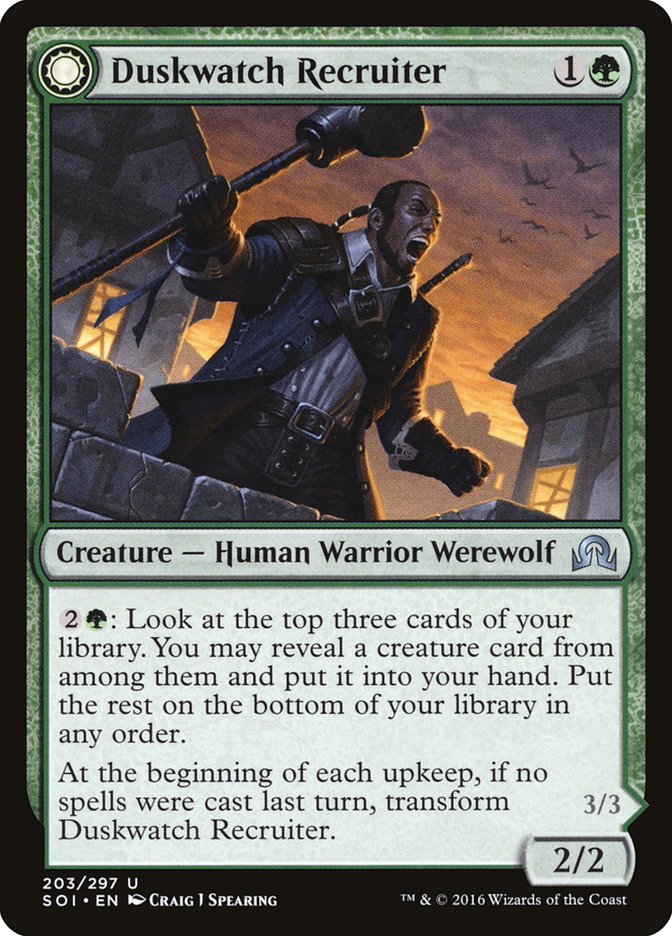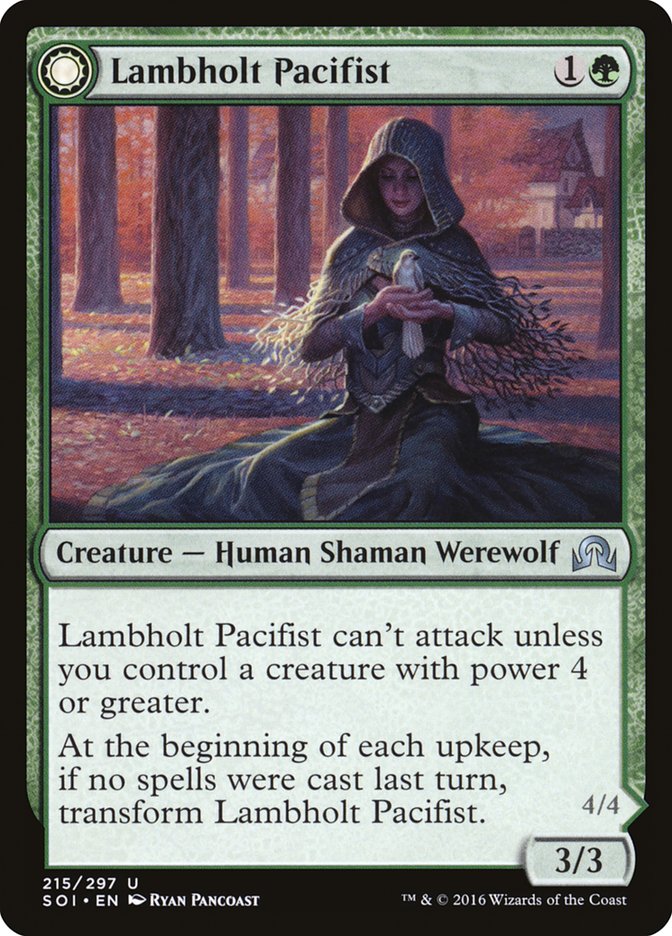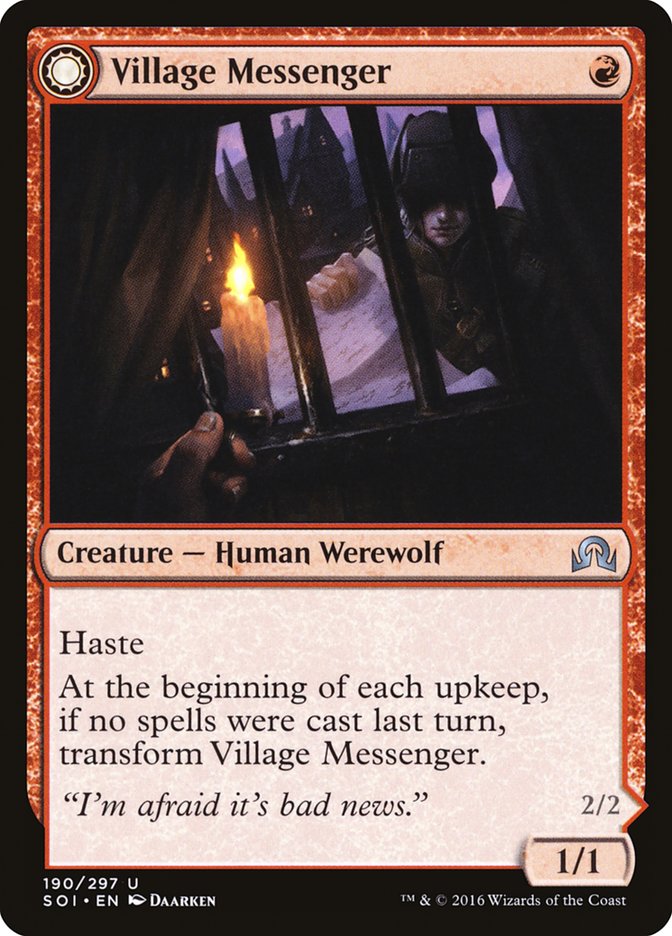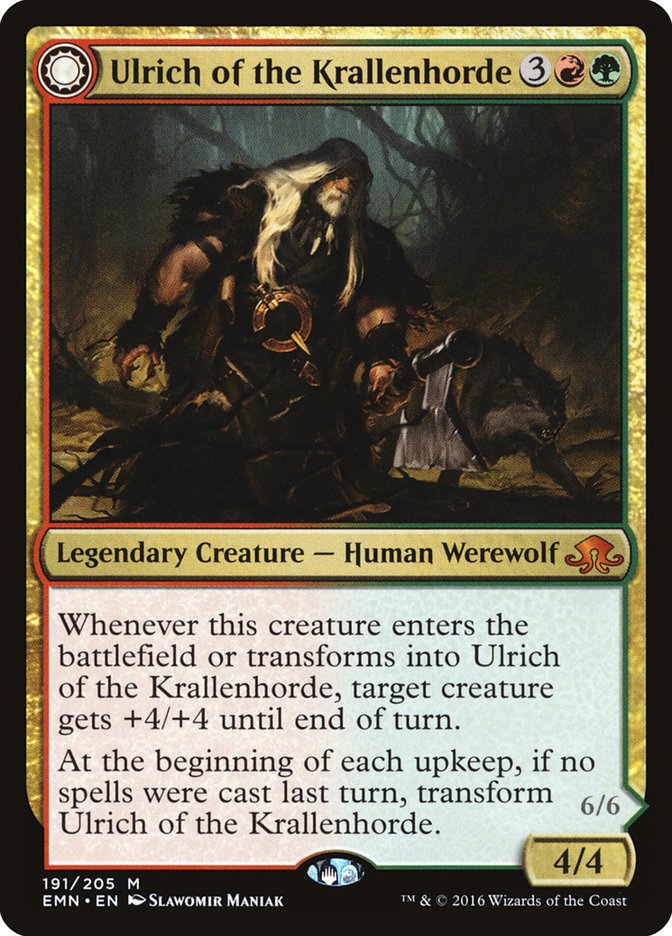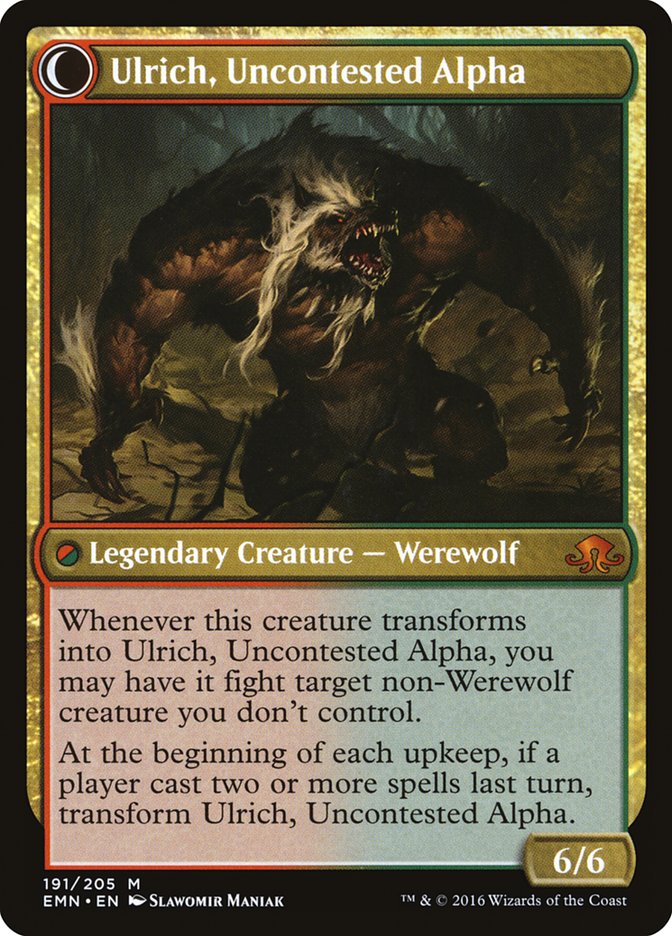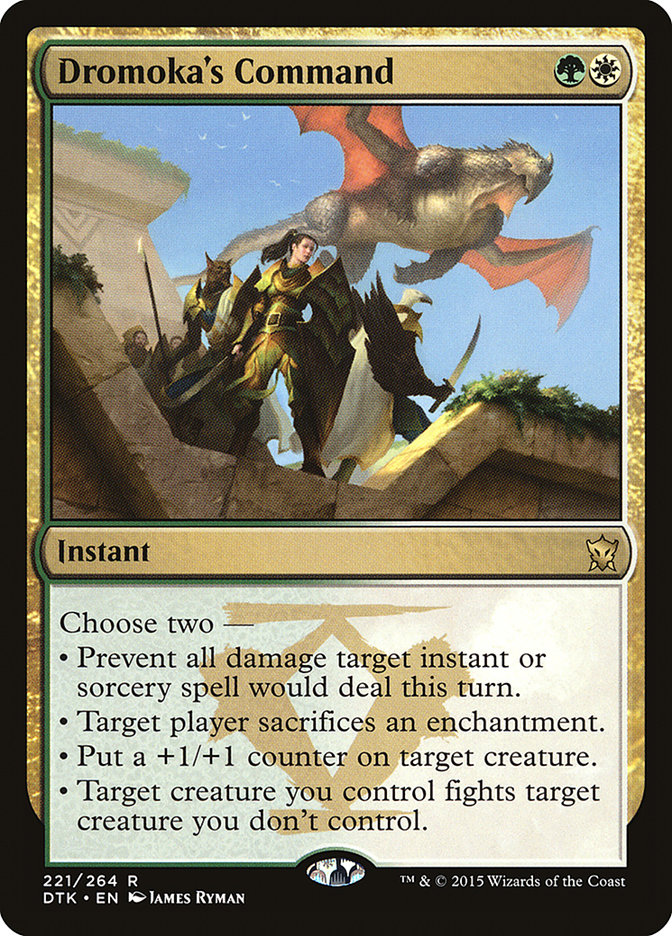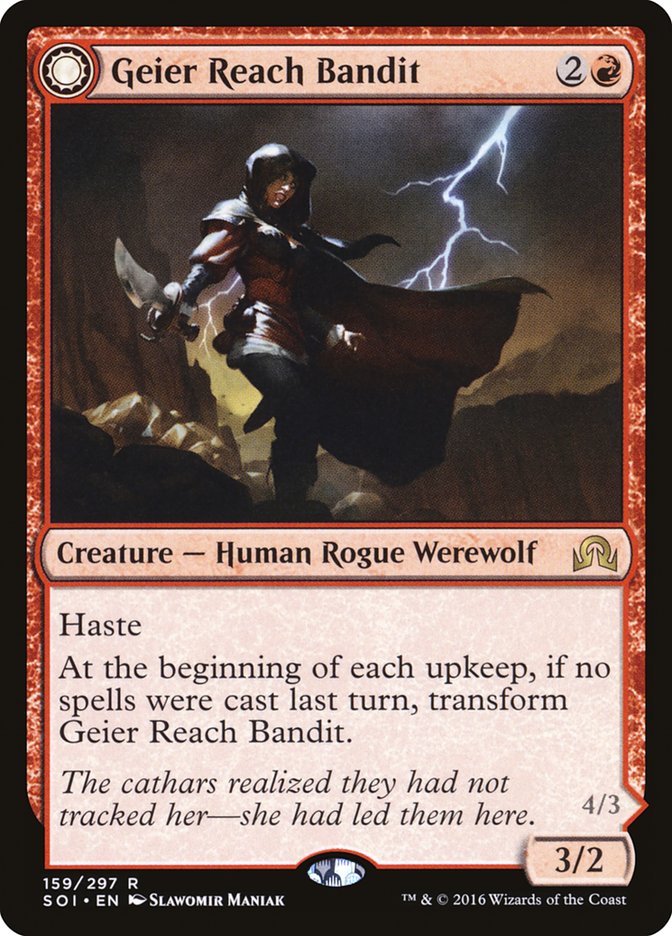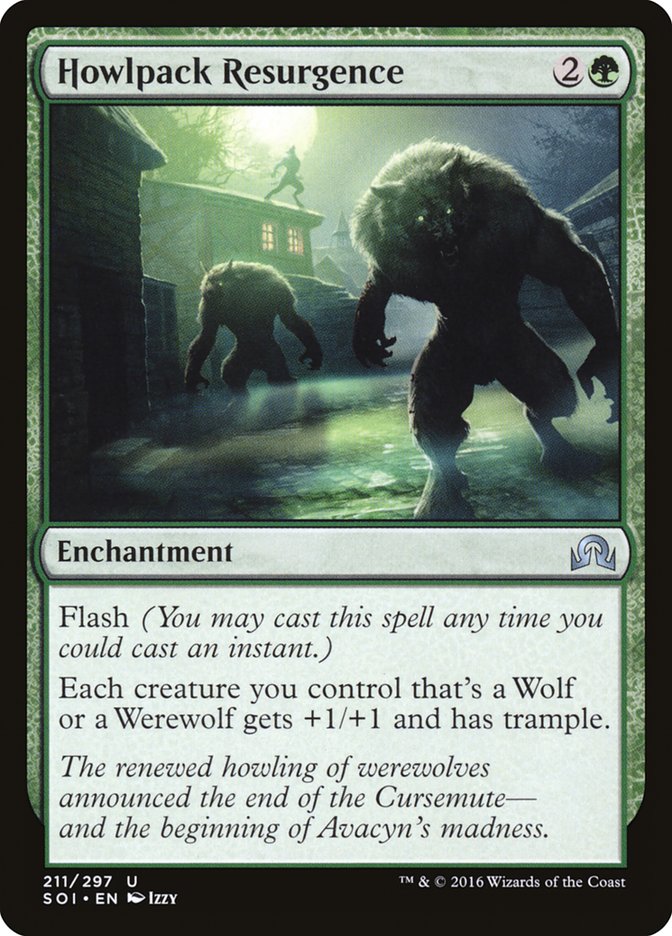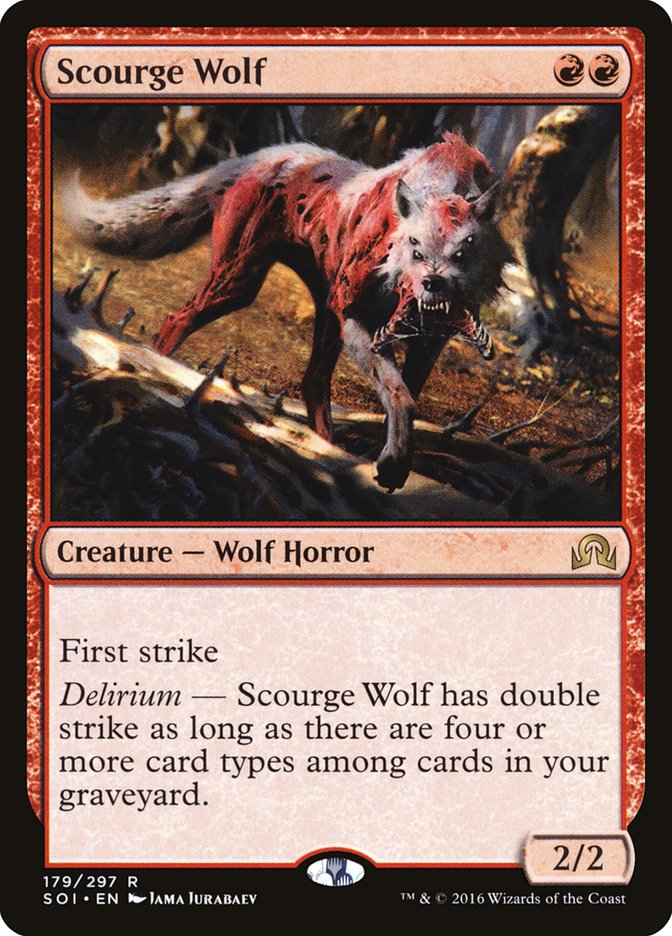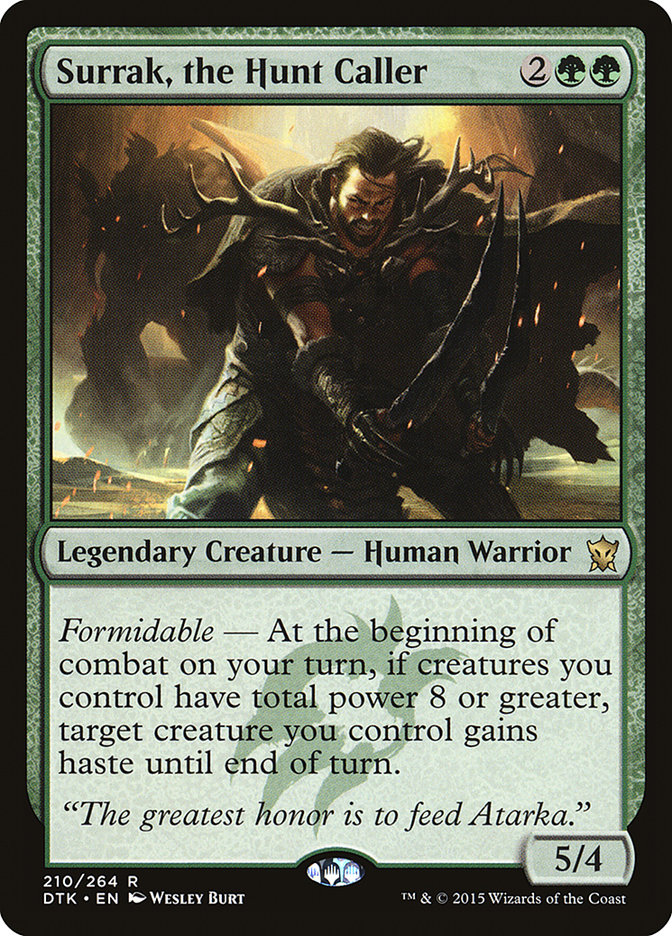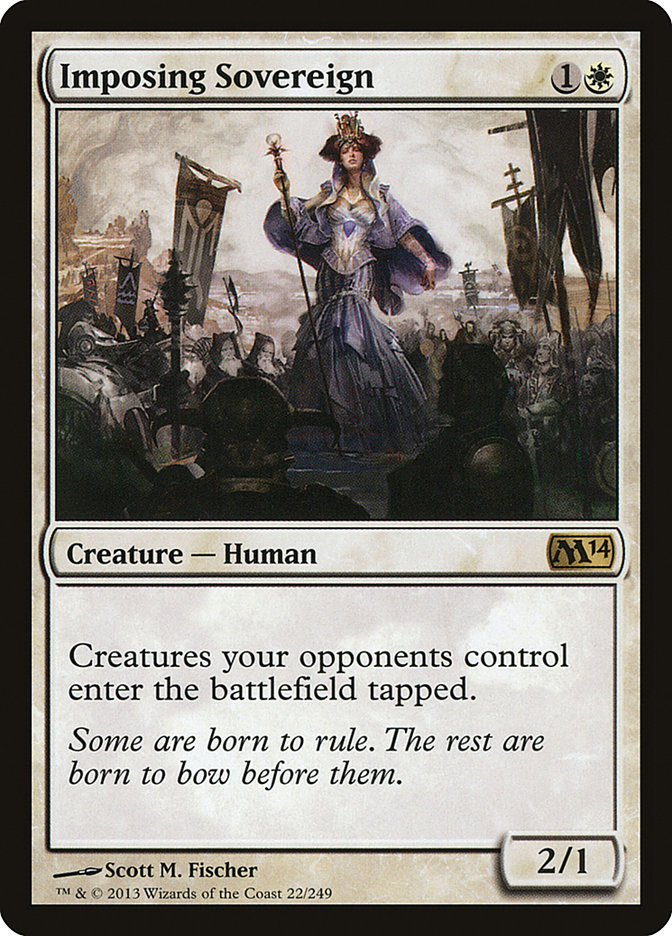What does it take for a Werewolf to be Constructed-playable?
We’ve already seen Duskwatch Recruiter and Lambholt Pacifist dominate, and Village Messenger sees a little play. Is the only way a Werewolf can be Constructed-playable these days to cost two or less?
It’s worth pointing out that Duskwatch Recruiter was not initially realized to be just as powerful as it really is. Lambholt Pacifist was an even bigger sleeper. Werewolves are hard to evaluate. The context they find themselves in also matters a lot.
Eldritch Moon spoiler season has just kicked off, and so far, Emrakul, the Promised End has dominated the conversation. This is no surprise, as Emrakul has been hotly speculated about and discussed for many months now. At the end of the day, the new Emrakul looks very promising and is well worth building around. However, she’s not the only new legendary creature on the block. Let’s take a look at the new legendary Werewolf that I think has chances of Constructed play despite being a five-cost Werewolf.
To start with, Ulrich of the Krallenhorde is sort of like a 4/4 creature with haste. The +4/+4 needs another creature on the battlefield, but you are splitting up your investment. If your opponent uses an instant-speed removal spell on the threat that turn, Ulrich lives. If they use the removal spell on Ulrich, they still take four. It’s also important to remember that giving a creature +4/+4 can often let loose a creature that was previously unable to attack.
That’s not quite enough for five, but it’s not far. We’d probably be interested in a 4/4 that gave +4/+4 for four mana, so we only need to get a mana worth of value from the flipping to make Ulrich worth considering. That means, if our Ulrich never flips, he’s not gonna be worth it. However, if he flips just one game in three, he might be worth it, if we’re getting enough bang for our buck during that one game.
When Ulrich flips into Ulrich, Uncontested Alpha, he grows to 6/6, which is already a big boost. If there were a five-cost 6/6 creature that gave something +4/+4 when it entered the battlefield, it would surely see play. Ulrich is definitely not flipping 100% of the time or anything, but we haven’t even gotten to his flip-trigger yet. My point is just that, even with no targets for the flip trigger, we’re already kind of doing it when we flip him, if only for the body.
A little odd that Ulrich goes by Uncontested Alpha when his primary goal is to get into a contest. I’m not saying he loses many contests. I’m just saying I’m not sure “Uncontested Alpha” is the most apt description. Nevertheless, the ability to start a fight with a non-Werewolf opposing creature is a very strong one. After all, a 6/6 is winning most fights, and if your opponent had a kill spell, how did things get to this point anyway? I mean, if they’re going to kill him, we’re not actually any worse off. They could have just killed him already.
Yeah, it’s possible for things to go wrong. Maybe your opponent has a pump spell and the fight doesn’t go as well as planned? The thing is, there aren’t really that many pump spells people play, and even if they have a Dromoka’s Command or whatever and can make it work, it’s not like that was a dead card that suddenly had purpose or whatever.
It is a little bit of a parlay to get your five-cost legendary Werewolf onto the battlefield, and he lives, and he flips, and there’s a fight to be had, but that is a really big swing in the game if it ever happens, and we’re not exactly paying that much for it. Getting to kill a creature like that is often worth at least three mana, so getting to do it once every three games would already be a big deal, and that’s not even taking into consideration the extra body.
Realistically, I think it is ambitious to think Ulrich is getting to kill something with his flip-trigger one in three games, but it’s not out of the question. With the extra body in the equation, we might even be content with just flipping one in three and not getting a fight some of the time.
But wait, there’s more. See, Ulrich can flip back, and if you managed to get him to flip back on your opponent’s turn, he’s crashing for eight damage on your turn thanks to his trigger. Additionally, it’s not hard to imagine him flipping back to Uncontested Alpha almost immediately. This snowballing effect will be devastating when it goes down, but when you start getting that kind of an advantage, there are diminishing returns to winning even harder in those games.
Let’s take a look at some possible homes for Ulrich. We might as well get it out of our systems and start with a dedicated Werewolf deck. I have a hunch that there may actually be a playable Wolf deck by the time Eldritch Moon is fully spoiled. I don’t think Ulrich is enough to bring it all together yet, but it’s a step in the right direction.
Creatures (21)
- 1 Hinterland Logger
- 4 Village Messenger
- 4 Lambholt Pacifist
- 1 Pack Guardian
- 4 Duskwatch Recruiter
- 4 Geier Reach Bandit
- 3 Ulrich of the Krallenhorde
Planeswalkers (4)
Lands (25)
Spells (10)

We’re just not there yet in terms of trying to be explicitly Werewolves. What’s the payoff? Geier Reach Bandit is something, but we’re going to need more than that.
Geier Reach Bandit has the advantage of not needing to flip to at least be passable. A 3/2 haste creature isn’t particularly well-suited to the current Standard landscape, but it’s not unreasonable. If it flips, you get to have a lot of fun with Ulrich, of course. Now, when you cast Ulrich, you’re going to get his +4/+4 and immediately flip into a 6/6 that fights a potential blocker. Hell, if you needed, you could even use Ulrich’s pump on himself so that he can take down an 9/9!
Another potential tactical use of Ulrich’s +4/+4 is on Lambholt Pacifist. Even if the Pacifist is currently in passive mode, Ulrich knows how to push some buttons and get it interested in crashing for seven. Giving a +4/+4 boost to a trampler is also something to consider. The best way to get trample?
Howlpack Resurgence is a legit reward for staying on-tribe. A +1/+1 and trample Anthem for three is already a thing, but getting to play it at instant speed? That’s big, especially when you factor in how much Werewolves appreciate when you can play a flash game.
The thing is, Howlpack Resurgence doesn’t need your creatures to be explicitly Werewolves. They can just be everyday run-of-the-mill Wolves, like Arlinn Kord brings to the party. Of course, they can also be fancy Wolves, like Scourge Wolf.
Double strike, eh? Interesting…
Creatures (17)
- 2 Surrak, the Hunt Caller
- 1 Goblin Dark-Dwellers
- 4 Scourge Wolf
- 4 Lambholt Pacifist
- 4 Duskwatch Recruiter
- 2 Ulrich of the Krallenhorde
Planeswalkers (5)
Lands (23)
Spells (15)

Setting up delirium for Scourge Wolf is not trivial, but we don’t have to make that big of sacrifices. It would just be nice if we didn’t have to rely on Traverse the Ulvenwald for sorceries, as double red for Scourge Wolf on two is not the most natural fit for a Traverse deck.
Once we do get the double strike online, however, it does some pretty big things in this deck. Howlpack Resurgence, Atarka’s Command, and the various planeswalker pumps all do double duty. However, the really splashy combo is Ulrich of the Krallenhorde giving his +4/+4 to the Wolf for a surprise twelve damage out of nowhere.
Surrak isn’t a Wolf, but he combos quite nicely with Ulrich. This list might actually be a little short on ways to get Surrak active, so we might need to fit in more three-power creatures like Geier Reach Bandit in order to justify the slot. That said…
Creatures (26)
- 4 Thunderbreak Regent
- 2 Surrak, the Hunt Caller
- 2 Nissa, Vastwood Seer
- 2 Goblin Dark-Dwellers
- 4 Sylvan Advocate
- 4 Tireless Tracker
- 2 Lambholt Pacifist
- 4 Duskwatch Recruiter
- 2 Ulrich of the Krallenhorde
Planeswalkers (2)
Lands (25)
Spells (7)

Now we’re getting somewhere!
Moving away from Wolf tribal frees us up to play with awesome cards like Sylvan Advocate, Tireless Tracker, and Thunderbreak Regent. Remember, giving your own Thunderbreak Regent +4/+4 does not do damage to you, as the Regent only hurts opponents.
As the new cards come in, I’m going to be keeping a close eye on what might help round out R/G Mid-Speed Aggro. Ulrich is not a sure-fire hit, as he does have to compete with awesome five-drops like Goblin Dark-Dwellers and Reality Smasher, but he’s at least worth getting into the discussion. If he finds a good home, I think it’s probably going to be because of a strategy consistently valuing the +4/+4 at an above-average level (whether because of double strike, lifelink, or some other reason). It’s a novel ability that we don’t normally get tacked on to a legendary mythic.
There’s another new card I wanted to touch on, though the applications are relatively straightforward. It’s the new Thalia, a Heretical Cathar or Cathar Heretic, a 3/2 for 2W with “Creatures and nonbasic lands your opponents control enter the battlefield tapped.” (Note that this spoiler isn’t official yet, only known through a Spanish Buy-a-Box image, but the consensus is that it’s real. Still, spoiler season can throw us curveballs.)
The new Thalia is not really an update to Thalia, Guardian of Thraben so much as she is an update to Imposing Sovereign.
Imposing Sovereign was a deceptively aggressive creature that made it hard for opponents to ever really cobble together a blocking plan. That the new Thalia does so attached to a 3/2 first strike body is very attractive. The rate on her is so good, she doesn’t necessarily ever need to tap down anything for her to be pulling her weight.
Of course, tapping creatures isn’t her only hobby. Her ability to slow down nonbasics is going to matter a lot. She obviously slows down Battle lands, Shadow lands, and painlands, but she also messes up stuff like Evolving Wilds and Westvale Abbey. It’s too bad she wasn’t around for fetchlands, as she taps down the fetches and then forces the opponent to choose between getting a basic and getting tapped a second time after finding a Battle land.
Thalia is going to make it especially important to sequence your lands correctly and avoid getting “Time Walked” on turn 4 or 5. You’re generally going to want to get your nonbasics onto the battlefield as soon as is convenient and save the basics for when you need to play them. Of course, this also needs to be balanced against making sure you hit your color requirements and can play a Battle land untapped when they don’t have Thalia.
Another important feature of Thalia? She’s a Human. Just add two copies of her to this list:
Creatures (29)
- 4 Knight of the White Orchid
- 4 Dragon Hunter
- 3 Kytheon, Hero of Akros
- 2 Anointer of Champions
- 4 Expedition Envoy
- 4 Thraben Inspector
- 4 Thalia's Lieutenant
- 4 Town Gossipmonger
Lands (18)
Spells (11)
Sideboard

You wanna be careful and not go overboard on three-drop legends in a deck with this low of a mana curve. That said, I could easily imagine restructuring the deck to go a little bigger in order to make more use out of Thalia. For instance, if we play blue for Reflector Mage, we can really frustrate any attempts by our opponent to block. Remove the blocker with the Mage while you have Thalia on the battlefield, and it won’t be able to block for three turns.
Another way to take advantage of Thalia is to emphasize her tempo-building powers. She’s even the perfect cost to put into a Collected Company deck! Add two copies maindeck and one sideboard to this:
Creatures (25)
- 4 Reflector Mage
- 3 Eldrazi Displacer
- 3 Thraben Inspector
- 4 Thalia's Lieutenant
- 3 Tireless Tracker
- 4 Lambholt Pacifist
- 4 Duskwatch Recruiter
Lands (25)
Spells (8)

Playing a 3/2 first strike creature off a Collected Company is awesome in the middle of combat; however, we can also respond to our opponent casting a creature and look for Thalia. We want to make sure our Reflector Mage is still a good hit, but getting to surprise someone with a Thalia could really disrupt their blocking plans.
Another cool thing you can do with Thalia is cast her precombat, in order to ensure that you don’t get blown out by an opposing Collected Company. They might still respond to your Thalia, but at least you’ll know what they’re hitting.
Dromoka’s Command (or any other permanent instant-speed pump spell) works great with first strike. It’s hard enough to stop a 3/2 first striker, but a 4/3 first striker is just brutal.
I don’t think the new Thalia is going to revolutionize the format or anything, but she’s got such a good rate and can be so disruptive with an ability we’re kind of getting thrown in for free that I think she will regularly find multiple homes.


